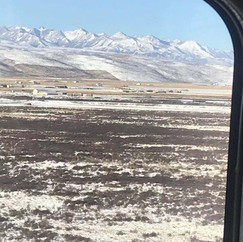Winter on the Old Silk Road
- Carol Anne Jones

- Jan 16, 2021
- 4 min read
Updated: Feb 12, 2021
Over the Christmas break I embarked on a seven day tour to a region in northwest China. This landlocked part of this huge country includes the autonomous regions of Xinjiang, Ningxia and the provinces of Shaanxi, Gansu and Qinghai. So Gansu and Qinghai was where I was headed. It's a place with a diverse cultural mix of people and food; Tibetan, Buddhist and Muslim. Geographically, plateaus are the dominant physical feature of the land. Along the southern border, the ranges of the Qilian mountains separate Gansu from Qinghai, and these ranges have an average elevation of 12,900 feet (3,900 metres) above sea level. The trip was billed as a winter tour of the Old Silk Road, winter yes! I was warned the temperatures would be cold and they were, -4 to a low of -15 C, at night. Oh yes, was I glad I packed a woolly hat, gloves and thick quilted long coat, but despite the cold it was going to be a trip to remember.
So, on Christmas Eve, I flew from Beijing to Xining in Qinghai province, to meet up with the rest of the party and after arriving we immediately hopped on the bus to make a visit to the Tibetan Buddhist monastery called Ta'er otherwise known as Kumbum. Here the highest populous of monks outside of Tibet live and a very humbling experience to see them it was in their deep red cloaks going about their daily business.
The next day early in the morning, we caught a bullet train from Xining train station to Zhangye. It was fast with glimpses of the dramatic landscape from the comfort of a chair. Departing straight from the station we headed for the Mati or Matisi Temple built during the Jin Dynasty, located in a huge park full of sacred temple grottos perched on the cliff faces containing statues and delicate murals. It was back to Zhangye for the night and a Christmas Day evening meal, quite different from my last year's Christmas Day in the tropics of Bali at the St Regis.
In the morning the guide took me for my second Covid test ready for the return back to Beijing, yes another, having only just had one in Beijing to come on the trip. All negative! Zhangye I discovered, is located midway in the Hexi Corridor, a place known for its wealth of natural resources provided by melting snow and glaciers from the Qilian mountains. The city itself has a centre piece, the Giant Buddha Temple, noted for its gigantic reclining Buddha statue made around 1100 C.E, measuring thirty five metres long. The afternoon was spent in Pingshanhu canyon hiking, described as the Grand Canyon of China, surreal because of its Martian inspired landscape. There were options for the hike and I chose to walk along the top rather than down hundreds of stairs to the bottom which was fine, it was the upward climb up a spiral staircase that I guiltily avoided but hey I was holiday!
Another geological wonder awaited in the morning, after breakfast we were off to the Zhangye Danxia National Geological Park, the Rainbow Mountains; a mountain range of cretaceous sandstones and siltstones all deposited before the Himalayan Mountains were formed. I learnt that the sand and silt contains iron and trace minerals that form the colours of red, orange and yellow that slice through the rocks to create the famed rainbow effect. After a lot of hiking and some delicious local food, the next stop was Jiayuguan for an overnight stay. The hotel was luxurious and the breakfast good, then in the morning we visited the Jiayuguan pass, featuring the most westerly part of the Great Wall and a fortress, built during the Ming Dynasty. The vista at the uppermost beacon tower after a 500 step climb in the snow was magnificent, yes an exhausting climb but worth it. The fortress was built around the year 1372 built between the legendary town of Kashgar to the west and Dunhuang to the east, a famous waypoint along the Silk Road. During the age of the Chinese Kingdom, the fortress protected the Western border, it had a fearless reputation and it’s said that those exiled from the kingdom by the Emperor were ordered to head west into the vast Gobi desert and never return.
Then a five hour drive took us through the Gobi desert to the final stop of Dunhuang, once an important hub place for trade on the Silk Road, where people once met to commerce all kinds of products. The hotel reminded me of the Middle East with its Arabian flavour due to the local Muslim heritage. How I miss the Middle East I discovered. In the morning we soaked in the Mogao Grottoes, also known as the Thousand Buddha Grottoes, a UNESCO World Heritage site. In the freezing cold amongst some film crews, the guide took us through eight grottoes to view the mural sand paintings which were created during the Sui, Tang and Song dynasties. It was fascinating to glimpse the evolution of Buddhist art depicting the medieval politics and economies of the time. According to legend, in 366 C.E., a monk named Yuezun had a vision of a thousand radiant Buddhas on the cliff face, which inspired him to begin excavating the caves. The tour took four hours which included an IMAX movie, and then we made our way to the Echoing Sand Mountain and Crescent Lake, a huge sand dunned area where the wind entwined with the dunes often make a loud almost like some type of ancient musical instrument. Apparently, the Crescent Lake's been in existence for hundreds of years without ever being covered by sand. So I took a refreshing camel ride, very refreshing in the wind, then walked around, beautiful unlike any of my previous desert experiences.
Ah, in the morning after a simple breakfast of vegetables and eggs, the airport awaited for the flight back to Beijing. The Old Silk Road, a whistle stop tour but one I’ll never forget,
A Happy New Year to you all, stay safe and see you in February!











































































Comments